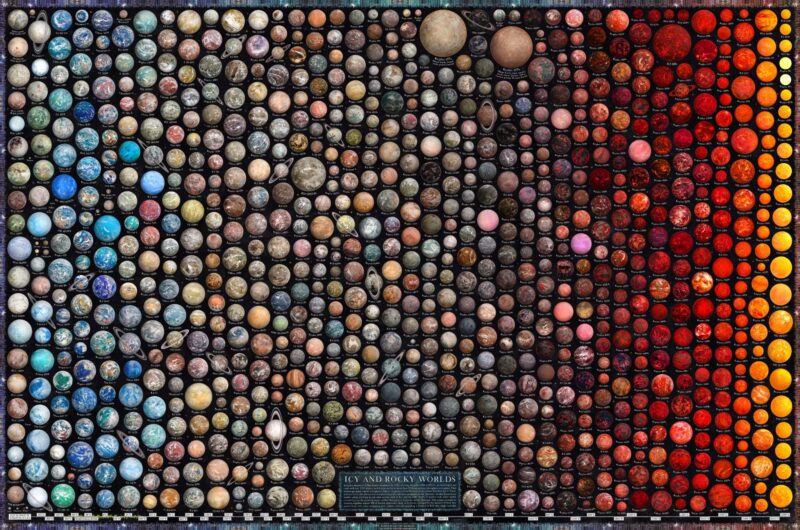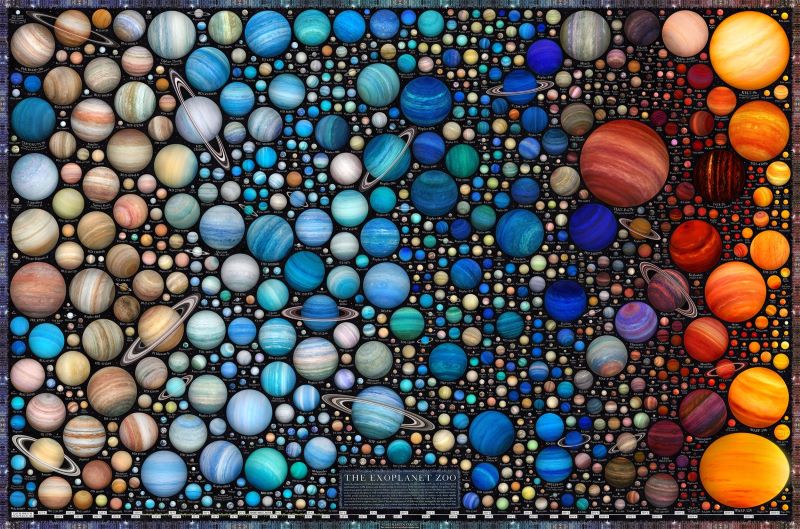
Exoplanet art by Martin Vargic
Take a closer look at the exoplanets above, and get to know icy and rocky worlds around alien stars. Martin Vargic is a Slovak space enthusiast, author and graphic artist who created many infographics on his page. This art is his attempt to artistically visualize and compare thousands of exoplanets of all types and sizes according to observational data. And it’s our chance to get a better look at what our greater Milky Way neighborhood might look like.
About the icy and rocky worlds infographic, Martin said:
Since the discovery of first known exoplanets in 1992, we have found and confirmed over 5,332 distinct and diverse worlds in more than 3,930 star systems throughout our galaxy.
With the help of scientific models and up-to-date information, this poster attempts to artistically visualize more than 800 known exoplanets believed to be rocky or terrestrial, arranged by the amount of heat they receive from their stars, comparing their relative sizes and providing a window to how they might look.
Using methods such as doppler spectroscopy, microlensing and transit photometry, we are able to estimate dimensions and mass of many planets with considerable accuracy, as well as calculate the amount of heat that reaches them from their star.
The 2024 lunar calendars are here! Best Christmas gifts in the universe! Check ’em out here.
A closeup on terrestrial worlds
As you take a closer look at each world, you’ll see they’re all labeled to represent specific discoveries. Martin explains some of the famous exoplanets he has illustrated:
TRAPPIST-1b is one of eight planets that orbit around a dim red dwarf star. All would fit well within the orbit of Mercury. Planets come so close to each other that neighboring planets can appear as big and bright in the night sky as our moon.
Proxima b is a terrestrial exoplanet slightly bigger than Earth, in the habitable zone of Proxima Centauri, at 4.25 light-years away. In the future, it is likely to be the first exoplanet we send a probe to. Such a journey might take less than a century.
Kepler-277b is a ‘mega-Earth’ rocky planet almost as massive as Saturn. Its sheer mass causes it to contract inward. It has a solid surface, and its surface gravity is crushingly powerful: over 10 times stronger than Earth’s.
55 Cancri e is a planet with a confirmed lava ocean covering its surface. The planet’s interior is likely heavily composed of carbon, most of which is in the form of diamond.
Kepler-70b is possibly the hottest exoplanet known, with its surface hotter than the surface of the sun. Originally, it might have been a gas giant that had its gases stripped away by its star, leaving only a rock-and-metal core. The heat of its star will eventually completely vaporize the planet.
Ring systems on the infographic are an artistic addition. It is not inconceivable that many rocky planets in the galaxy might have a ring system. Mars itself will have a ring system of its own in the future, when its moon Phobos spirals too close to the planet.
Exoplanet art with the gas giants
Martin has also created an exoplanet infographic with the addition of gas giants. The artwork below illustrates more than 1,100 known exoplanets of all different types. Check out a higher resolution of his infographic here.

A closer look at the gas giants
Martin also gave insight into some of the more famous gas giants that he illustrated:
TrES-2b, a hot gas giant, is the darkest known exoplanet. It reflects less than 1% of light from its star, making it darker than coal. Its atmosphere is rich in vaporized alkali metals, making it exceptionally good at absorbing light.
KELT-9b is the hottest confirmed exoplanet. Its dayside temperature approaches 7,808 F (4,320 C), enough to melt any known material. On its day side, molecules break into their component atoms. Its atmosphere contains vaporized titanium and iron, and its star covers over 35% of the planet’s daytime sky.
WASP-12b is a scorching hot Jupiter located so close to its star that tidal forces are stretching it into the shape of an egg. Hot gas continuously escapes from its day side, siphoned by its hot star. Its star will completely consume it in less than 10 million years, the same fate that awaits Mercury, Venus and possibly even the Earth.
Bottom line: Enjoy the exoplanet art of Martin Vargic. Martin illustrated more than 1,000 exoplanets based on astronomers’ discoveries of alien worlds around other stars.











